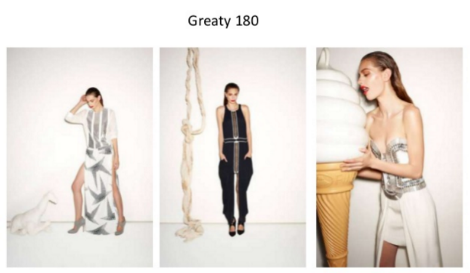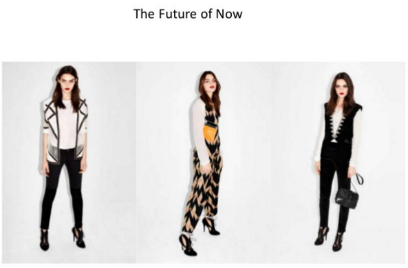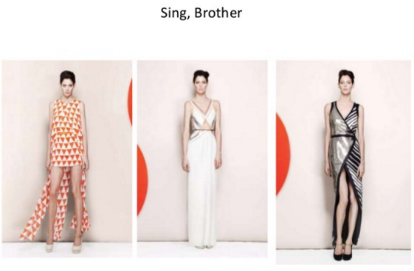Executive summary
This report discusses the would-be objectives/effects of adopting the so-called ‘word-of-mouth’ approach to marketing by Sass & Bide (Australian clothing/fashion company), and introduces readers to some recommendations, as to how this Company should pursue to make the best out of the marketing strategy in question.
In the report’s initial sub-chapters, readers learn about what accounts for the discursive significance of WOM, as the marketing model closely associated with the realities of today’s living. The report’s midsection contains suggestions, in regards to the practical ways of implementing the proposed initiative by Sass & Bide. The report’s concluding sub-chapters provide readers with information, as to what should be considered the would-be implementation’s pros and cons to the Company’s overall competitive standing. The report also contains suggestions for the approximated quantities of time that will be required to complete each of the proposed implementation’s phases.
The main idea, promoted throughout the report’s entirety, is that there are indeed many objective reasons to believe that in the aftermath of having embraced the WOM-based marketing philosophy, Sass & Bide will be able to increase the measure of its market-competitiveness. Another idea, advocated by this report, is that the rising popularity of WOM-marketing has been objectively predetermined by the discourse of post-modernity, which continues to affect the workings of the world’s economy to an ever-larger degree.
Introduction
One of the most notable effects of post-modernity on the qualitative dynamics in the worldwide market of goods and services, is that as time goes on, more and more Western consumers tend to assess the utilitarian significance of a particular good/service, in regards to what happened to be its ‘perceived’ (highly subjective) value (Riviere & Mencarelli, 2012). This situation can be explained by the continually increased standards of living in the West, which comes at the partial expense of people’s civil rights and freedoms being progressively limited. In its turn, such a tendency naturally facilitates the anxiety of attaining self-actualization through consumerist individuation in people – hence, causing their purchasing choices to become increasingly irrational. The concerned tendency, however, creates a number of additional marketing opportunities for the companies that operate in the fields of fashion, FMCG-retailing, and pharmaceutics. The reason for this is that, as practice indicates, it is specifically one’s awareness of what accounts for the ‘perceived ‘ value of the affiliated products, which affects his or her purchasing decisions, in their regard, more than anything else does.
What it means is that these companies should never overlook the sheer beneficence of advertising their products in full accordance with the provisions of the so-called ‘word-of-mouth’ (WOM) marketing-model, concerned with, “Sharing of information from one person to another person or groups though human communication such as face-to-face contact, telephone, correspondence (letters, e-mail, text messaging) or social media” (Gombeski et al., 2011, p. 22). The rationale behind this suggestion is that the deployment of WOM marketing-strategies appears to be especially justified, when the dynamics in the targeted market are highly irrational/subjective. As Boyer et al. (2015) pointed out, “WOM is more influential when consumers do not have an objective basis for judging a product; therefore, they rely on WOM messages as a basis for judgment” (p. 104). Given the fact that Sass & Bide (based in Sydney, Australia) is clearly affiliated with the fashion-industry, it will be thoroughly logical to assume that the above-mentioned line of reasoning applies to it, as well. This report aims to explore some of the would-be effects of this Company’s decision to incorporate WOM, as an integral part of its marketing strategy. It also seeks to outline the set of discursive recommendations, relevant to the issue at stake.
Marketing issue
The main indication that that WOM is indeed an utterly effective marketing strategy has to do with the fact that it is fully consistent with the working of one’s consumerist psyche: “Consumers are… thousands of times more likely to act on a recommendation of a friend, colleague, or trusted advisor than… a commercial communication” (Silverman, 2001, p. 23). This simply could not be otherwise, because it is in people’s nature to believe that the socialization-triggered informational transactions are the most ‘trustworthy’ ones. Moreover, the conceptual premise of WOM takes into account the 21st century’s main marketing challenge – the fact that, due to the exponential progress in the field of IT, companies are required to invest the ever-increased amounts of money into ensuring the practical effectiveness of their conventionally designed advertising-campaigns. Thus, it will be fully appropriate to suggest that by choosing to take practical advantage of WOM, a particular company does nothing short of increasing the extent of its commercial competitiveness. The validity of this statement can be illustrated, in regards to the most obvious beneficial effects of WOM’s deployment, such as the speedy and cost-effective dissemination of information, the psychological plausibility of delivered advertising-messages, and affordability (Armstrong & Kotler, 2005). There is another important advantage to the adoption of WOM – it makes possible for even comparatively small fashion-companies (such as Sass & Bide) to achieve high sales within the short period, without having to invest in any conventionally designed advertisement-campaigns.
Examples
There are indeed a number of examples of the deployment of WOM by a particular company having proven utterly beneficial. Probably the most notable of them is the story of Zara – a Spanish-based retailer of clothing/accessories, which during the course of recent years was able to gain a global fame, due to its truly innovative retailing strategy, concerned with the Company’s decision to refrain from advertising its products in the conventional manner altogether, and with adopting WOM as the only used marketing-tool. This move allowed Zara to save money and consequently to retain its production lines in Spain (as opposed to ‘outsourcing’ them to China), which in turn resulted in both: ensuring the high quality of Zara-branded clothing, and enabling the Company to shorten its conception-production cycle (Matherly & Richards, 2013). This naturally increased the commercial appeal of Zara’s clothing among consumers.
To exemplify even further the validity of the suggestion that Sass & Bide should benefit from affiliating itself with WOM marketing-strategies, we can refer to yet another clothing retail-company – H & M (Swedish-based). In the manner similar with that of Zara, H & M makes a deliberate point in relying mainly on ‘word-of-mouth’, within the context of how this Company advertises its products. In the case of H & M, this marketing-strategy extrapolates in the Company’s effort to expand the sphere of its online presence, as such that allows H & M to react promptly to the hardly predictable fluctuations in the global fashion-market. As a result, H & M was able to make sure that its marketing messages are not only delivered to the targeted populations, but also that these messages correlate well with people’s fashion-related anxieties.
The company’s current marketing strategies
Ever since the time of its founding in 1999, Sass & Bide continued to rely mainly on the conventional methods of advertising clothing. For example, the Company has always been known for the extensive effort that it applies into ensuring that consumers perceive the brand Sass & Biden closely affiliated with the lifestyle of celebrities, “A successful marketing strategy used by Sass & Bide to launch their label internationally was having celebrities wear their clothing” (Australian Fashion, 2013, par. 19). To illustrate the validity of this suggestion, we can refer to the fact that it was namely in the aftermath of Sass & Biden’s jeans having been seen on Jessica Parker in the sitcom Sex and the City that the Company began to enjoy much popularity with Australian consumers.
Another marketing strategy, commonly used by Sass & Biden, is taking part in fashion-shows across the world and advertising the lines of its clothing in fashion-magazines and on TV. In this respect, the Company’s advertisement-campaigns Greaty 180, The Future of Now, and Sing, Brother, designed to promote the lines of women’s fashionable clothing, are especially notable.



These campaigns helped to establish Sass & Biden as a brand that targets specifically the sophisticate/urban women, who pay much attention to the recent trends in the world of fashion. What also contributed towards the commercial success of the brand in question is that its original owners (Heidi Middleton and Sarah-Jane Clarke) succeeded in strengthening the Company’s reputation of being closely associated with the concept of Corporate Social Responsibility (CSR) –something that increased the popularity of this brand-name among ethically-conscious consumers.
As of today, the Company’s new owners (Sass & Biden was acquired by Myer Group in 2011) investigate the additional opportunities for promoting the brand, such as adopting the ‘clicks-and-bricks’ operational mode, which enables people to purchase Sass & Biden’s clothing either at the Company’s ‘physical’ stores in Australia and the U.S., or online.
Implementation
In order to take full advantage of adopting WOM marketing strategy, Sass & Biden should embark on doing the following.
Creating the web-based communities of fans/loyal customers
This will allow the Company to notify consumers of recent corporate news/newly introduced products, and to remain thoroughly aware of the constantly fluctuating market-demands. The adoption of the proposed WOM marketing strategy will also enable Sass & Biden to strengthen the integrity of its brand-appeal, as such that has been objectively predetermined. The Company is already present in such social media as Facebook and MySpace. However, it is clear that Sass & Biden uses such online presence, on its part, to advertise new clothing, rather than to stay in close interactive touch with consumers.

In this respect, the emphases need to be reconsidered. The rationale behind this suggestion is that, “Consumers are more apt to spread positive word-of-mouth along with higher interactive involvement and the longer contact between consumers and products” (Qian & Guo, 2012, p. 49). Moreover, Sass & Biden should also consider striking a deal with the world’s largest WOM service-providers, such as Bzzagent (www.bzzagent.com), House Party (www.houseparty.com), and Communispace (www.communispace.com), which will enable the brand to expand the base of its ‘loyals’ even further.
Striving to gain the reputation of ‘opinion leader’ in the Australian (and possibly global) world of fashion
Discursively speaking, ‘opinion leadership’ is “A degree to which an individual is able to informally influence other individuals’ attitudes or overt behavior in a desired way with relative frequency” (Ertekin & Atik, 2012, p. 325). Because the realities of a post-industrial living presuppose that there is a positive correlation between the measure of a fashion-brand’s commercial competitiveness, on one hand, and the varying extent of its incorporation in the currently dominant socio-cultural discourse, on the other, there can be only a few doubts, as to the sheer appropriateness of such our suggestion. Given the qualitative essence of these realities, Sass & Biden should apply a continual effort into making sure that the brand-name in question remains on the tip of everyone’s tongue. In its turn, the best method (due to its cost-effectiveness) for accomplishing it is creating the objective preconditions for the name Sass & Biden to stir a public controversy. Once, convinced that the Company’s lines of clothing are controversial in one way or another, consumers will be naturally driven to the pass to each an opinionated ‘word-or-mouth’, in this regard. As the inevitable- consequence, the Company’s products will be deemed to represent an increased ‘perceived’ value (Sweeney, Soutar, & Mazzarol, 2008).
Assuming the full control of production/distribution
This particular initiative needs to be implemented, in order to ensure the high quality of the Company’s products and to shorten the lead-time, required for Sass & Biden-branded items of clothing to become available for purchasing at the stores. More specifically, Sass & Biden should decide in favor of setting its production-lines firmly in Australia, even though this will undermine the measure of the Company’s operational effectiveness. At the same time, however, the implementation of the proposed initiative will prove utterly beneficial to the corporate reputation of Sass & Biden, as a company that may never consider compromising quality for the sake of expanding its niche in the targeted market. Once, in the possession of such a reputation, it will be much easier for Sass & Biden to continue promoting its clothing within the conceptual framework of the WOM-paradigm of marketing.
After all, it now represents a well-established fact that, “The best word-of-mouth stems from the features of good and excellent consumer experience rather than perfect sales budget and advertising” (Lo, 2012, p. 190). After having proven its unwavering commitment to ensuring the highest possible quality of Sass & Biden’s clothing, the Company will be able to benefit from reducing the availability its products, as such that will naturally drive people to pay more visits to the Sass & Biden stores, as the way of addressing the issue of these products’ ‘scarcity’. Another effect of the proposal’s implementation will be the strengthening of the Company’s reputation as a ‘producer of styles’, rather than merely a producer of clothing per se. It is understood, of course, that the factor of WOM will play a crucial role, in this respect.
Advantages/disadvantages
The main advantages of adopting the WOM-based model of marketing by Sass & Biden can be outlined as follows:
Reduced risks
The issue’s implementation will result in expanding the scope of spatial limitations, associated with every line of Sass & Biden’s clothing. In its turn, this will reduce the negative impact of the situations when some of the Company’s products end up disfavored by consumers. Consequently, Sass & Biden will be in the position to experiment more with creating innovative fashions, while taking advantage of its decision to deploy WOM marketing strategies.
Increased resilience
The adoption of WOM by Sass & Biden will result in transforming the Company’s operational philosophy from that, concerned with anticipating/predicting the demand-dynamics in the Australian/global market of fashion, to the one that allows reacting to these dynamics, as they come into being. As a result, Sass & Biden should find itself much ahead of competition, in terms of what accounts for the measure of just about any company’s operant flexibility.
Increased efficiency
In the aftermath of having adopted WOM, Sass & Biden will be able to reduce its operational costs by 20%-30%, as a result of being no longer required to come up with the continually updated conventional advertisement-campaigns every so often. The saved funds could be used for strengthening the integrity of the Company’s logistical infrastructure.
The scope of the would-be affiliated disadvantages is narrower. The most notable of them can be formulated as follows:
The adoption of WOM by Sass & Biden may prove inconsistent with the marketing-related implications of the ongoing economic recession
The reason for this is apparent. During such a recession, consumers become increasingly price-sensitive and consequently – not just as prompted to consider paying money for the products and services that represent a strongly defined ‘perceived’ value (Warner & Zheng, 2013).
The continual deployment of WOM marketing-strategies by Sass & Biden may raise some ethical concerns
After all, it is specifically the overt WOM-based marketing endorsements that appear to be the most effective ones (Swanepoel, Lye, & Rugimbana, 2009). What this means is that, throughout the duration of their association with WOM, the Company’s managers must be willing to keep the targeted consumers psychologically manipulated. Moreover, the former must be capable of doing it skillfully.
Summarized recommendations
Sass & Biden should consider becoming affiliated with the WOM-based model of marketing, as such that is being fully consistent with the Company’s area of specialization. The validity of this suggestion becomes especially apparent in light of the earlier mentioned discursive aspects of economic post-modernity, which leave only a few doubts that, as time goes on, people in Western countries will grow increasingly preoccupied with seeking a ‘perceived’ value in products and services – that is, if the current economic recession does not last forever. Among the main recommendations, as to how this can be achieved in practice, have been mentioned the Company’s vertical integration and the managers’ willingness to take advantage of the most recent breakthroughs in the field of IT, as the key to ensuring that Sass & Biden becomes ever more responsive to the demands of the surrounding business-environment.
Implementation schedule
Based upon what we know about how long (on average) does it take other fashion-brands to have WOM thoroughly integrated, as the essential part of their marketing-strategies, we can come up with the following implementation schedule:
Expanding online presence: 4-6 months
The suggested timeframe reflects the fact that creating the web-based communities of fans/followers is a time-consuming process, and also the fact that the exponential progress in the field of IT presupposes the continual reassessment of the currently deployed approaches to doing it.
Acquiring the reputation of ‘opinion leader’: 1-2 years
The rationale behind this suggestion has to do with the fact that there must be a well-defined spatial consistency to how a particular company strives to win the attention of the public eye. What it means is that within the given timespan, Sass & Biden must not only succeed in becoming the focus of the social spotlight at least a few times, but also in convincing consumers that this will continue to remain the case into the future.
Vertical restructuring: 6 months
As practice indicates, six months is how much time organizational change takes on average. Therefore, even though our suggestion, in this respect, is rather speculative, it does make much logical sense – especially given the Company’s comparatively small size.
Conclusion
It is understood, of course, that the provided recommendations, as to how Sass & Biden can benefit from appropriating WOM marketing-strategies, are far from being considered exhaustive. Nevertheless, there is indeed a good reason to consider them fully applicable – the fact that these recommendations appear to correlate rather well with the discourse of post-modernity, serves as the best proof that this is indeed the case. We believe that the earlier deployed line of argumentation, in defense of the idea that the implementation of the proposed initiative will allow Sass & Biden to become more competitive, is fully consistent with this concluding remark.
References
Armstrong, G., & P. Kotler (2005). Marketing an Introduction.
Upper Saddle River: Pearson Prentice Hall. Australian Fashion. (2013). Web.
Boyer, S., Edmondson, D., Baker, B., & Solomon, P. (2015). Word-of-mouth, traditional and covert marketing: Comparative studies. Academy of Marketing Studies Journal, 19(1), 102-119.
CaseyHuth. (2014). Sass & Biden//brand case study [PowerPoint slides].
Ertekin, Z., & Atik, D. (2012). Word-of-mouth communication in marketing: An exploratory study of motivations behind opinion leadership and opinion seeking. METU Studies in Development, 39(3), 323-345.
Gombeski, W., Britt, J., Wray, T., Taylor, J., Adkins, W., & Riggs, K. (2011). Spread the word. Marketing Health Services, 31(1), 22-25.
Lo, S. (2012). Consumer decisions: The effect of word-of-mouth. International Journal of Organizational Innovation (Online), 4(3), 188-196.
Matherly, L., & Richards, C. (2013). ZARA: Chic and fast fashion. Journal of Strategic Management Education, 9(2), 81-98.
Qian, M., & Guo, G. (2012). A study of word-of-mouth marketing and its application strategies in the era of internet. Contemporary Logistics, (7), 47-50.
Riviere, A., & Mencarelli, R. (2012). Towards a Theoretical Clarification of Perceived Value in Marketing. Recherche Et Applications En Marketing (English Edition), 27(3), 97-122.
Sass & Biden (2015). Facebook. Web.
Silverman, G. (2001). The secrets of word-of-mouth marketing: How to trigger exponential sales through runaway word of mouth. New York: AMACOM.
Swanepoel, C., Lye, A., & Rugimbana, R. (2009). Virally inspired: A review of the theory of viral stealth marketing. Australasian Marketing Journal, 17(1), 9-15.
Sweeney, J., Soutar, G., & Mazzarol, T. (2008). Factors influencing word of mouth effectiveness: Receiver perspectives. European Journal of Marketing, 42(3), 344-364.
Warner, M., & Zheng, L. (2013). Business incentive adoption in the recession. Economic Development Quarterly, 27(2), 90-101.